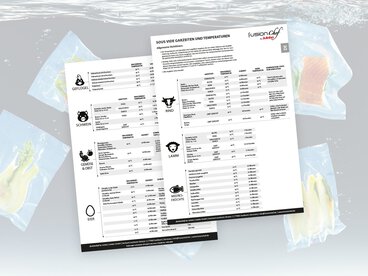Sous vide Cooking Chart with Temperatures & Times

In our easy-to-use sous vide cooking chart you will find helpful information about the respective cooking levels, core temperature, water bath temperature and the approximate cooking time. So you can achieve the perfect cooking results for you in no time. To make sure that everything works perfect, we have broken down the food very precisely, for example into beef (fillet steak, rib-eye steak, rump steak, strip steak, braised dishes etc.), lamb (loin, chop, T-bone steak, knuckle etc.), fish & seafood (shrimp, scallops, tuna, salmon, red snapper etc.), poultry (chicken breast, chicken leg, turkey breast etc.), pork (chop, sirloin, steak, roast, ribs etc.), vegetables (root, potatoes, beets, asparagus, cauliflower etc.), fruit (banana, pineapple, peach, strawberry, cherry, apple etc.) or the perfect onsen tamago.
Please always strictly adhere to the relevant hygiene standards, especially with regard to the cold chain, mise en place, processing, storage and regeneration. The higher the quality of the food used, the better the result. You can find detailed information on our website in the category 'All about sous vide'.
General guidelines:
- The temperatures and cooking times are approximate and depend on many factors such as quality, feeding, growing up, slaughtering, thickness of the food and ultimately of course also on personal preferences.
- Important: Raw or unpasteurized food should never be served to particularly sensitive individuals with weakened immune systems, pregnant women, children under four years of age or elderly persons. We recommend that for safety reasons, food should not be kept between 5 ° C and 55 ° C for longer than four hours. However, if you want to serve food to these people, we advise you to adhere to the relevant scientific pasteurization times and local regulations. More profound information on cooking times, pasteurization, HACCP concept, local regulations and much more can be found here
- Note that a constant and exact water temperature is essential for pasteurization. Even a temperature fluctuation of +/- 0.5 ° C or more will not give you a reliable result, as this will increase the cooking times disproportionately.
- All information without liability


